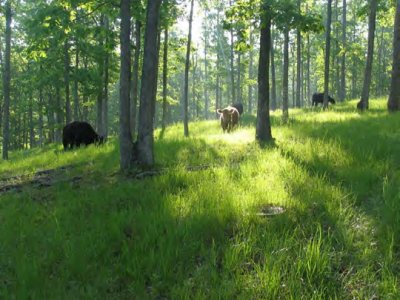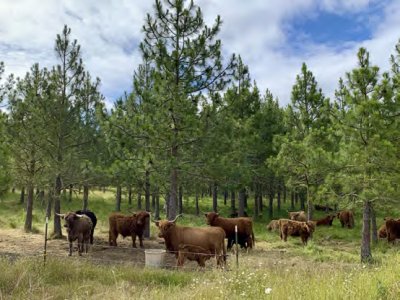AgEBB-MU CAFNR Extension
Green Horizons
Volume 24, Number 3
Fall 2020
Silvopasture in Missouri:
Investigating the potential of woodland grazing systems
Ashley Conway, Ph.D., Research Assistant Professor, Silvopasture, Center for Agroforestry
 |
Harwood Silvopasture - Livestock Grazing in Thinned Native Oak Stand - Wurdack Research Center, Cook Station, Missouri. |
Silvopasture, the intentional, designed integration of livestock with trees and forage or crops using managed intensive grazing, is one of the oldest agricultural systems in the world. Most farmers and ranchers today have adapted to modern markets by producing food in a very specialized manner, with limited or no integration between different agricultural products. At University of Missouri Center for Agroforestry, our silvopasture research aims to shift this paradigm to explore practical, productive, and profitable ways to re-integrate livestock with the natural landscape while increasing biodiversity in spaces that have been used exclusively for grazing.
Despite considerable interest in silvopasture, the demand for recommendations on how best to implement these systems regionally has outpaced the available information. Silvopasture is a flexible and versatile practice, but this means that local practices for one geographical area may not be well suited for other areas. Therefore, regionally-specific research is needed to inform management recommendations for local producers interested in knowing how they can build a functional silvopasture on their land with the best plant species.
Additionally, the majority of available silvopasture research has looked at establishing timber, specialty crop, or biomass trees into existing pastures to provide shade for the livestock and an additional stream of revenue for producers. This type of silvopasture may not work for every situation, and there are a number of people who are interested in learning how to make use of existing naturally wooded areas on their property in a responsible and ecologically sound manner. However, there are risks to grazing cattle in woodlands, and the best recommended practice at the moment is to exclude livestock entirely.
 |
Pine Silvopasture System. Photo Credit: Olga Romanova |
This summer, researchers at UMCA, in collaboration with the Missouri Forage and Grasslands Council and other departments across MU, received a $249,731 Research and Education grant from USDA Sustainable Agriculture Research and Education (SARE) North Central. This grant, titled "Investigating the Potential of Woodland Silvopasture Systems: Prevalence, Practices, Perceptions and Performance," will fund work over the next three years to address this growing area of interest among producers in the temperate Midwest.
The primary goals of this project aim to address major questions about the current level of silvopasture practice among Missouri producers, what producers feel the biggest barriers to adopting silvopasture are, and what the ecological and economic impacts of establishing a woodland silvopasture might be for our temperate region. Specifically, the project will:
- Evaluate current livestock grazing practices in wooded areas, perceptions of silvopasture, and potential for adoption among livestock owners.
- Utilize information gathered from the survey to develop a peer-learning network (PLN) among livestock producers in Missouri
- Evaluate a designated research site for baseline ecosystem measurements prior to silvopasture conversion, and monitor metrics for three years during the conversion process.
- Evaluate the economic costs of converting woodland silvopasture and estimate the value of the forage produced.
Over the course of this project, we hope to learn more about what livestock producers in Missouri need to improve the long-term sustainability of their land and their operation and investigate if woodland silvopasture is a viable option here to help reach these goals.
